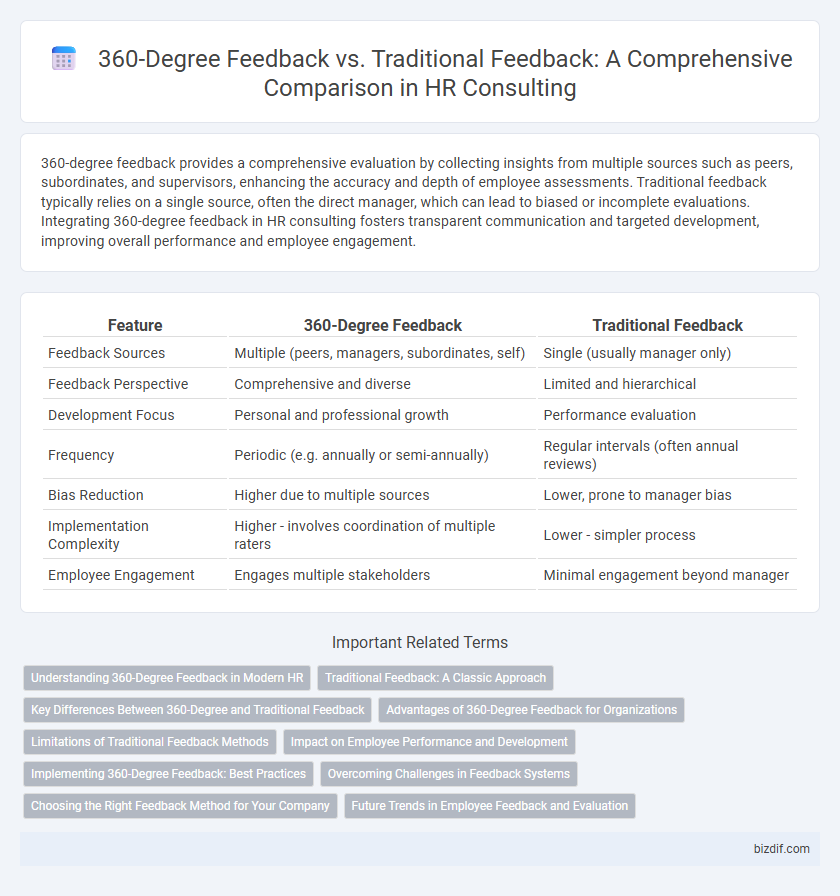360-degree feedback provides a comprehensive evaluation by collecting insights from multiple sources such as peers, subordinates, and supervisors, enhancing the accuracy and depth of employee assessments. Traditional feedback typically relies on a single source, often the direct manager, which can lead to biased or incomplete evaluations. Integrating 360-degree feedback in HR consulting fosters transparent communication and targeted development, improving overall performance and employee engagement.
Table of Comparison
| Feature | 360-Degree Feedback | Traditional Feedback |
|---|---|---|
| Feedback Sources | Multiple (peers, managers, subordinates, self) | Single (usually manager only) |
| Feedback Perspective | Comprehensive and diverse | Limited and hierarchical |
| Development Focus | Personal and professional growth | Performance evaluation |
| Frequency | Periodic (e.g. annually or semi-annually) | Regular intervals (often annual reviews) |
| Bias Reduction | Higher due to multiple sources | Lower, prone to manager bias |
| Implementation Complexity | Higher - involves coordination of multiple raters | Lower - simpler process |
| Employee Engagement | Engages multiple stakeholders | Minimal engagement beyond manager |
Understanding 360-Degree Feedback in Modern HR
360-degree feedback in modern HR offers comprehensive evaluations by collecting performance insights from an employee's peers, subordinates, supervisors, and self-assessments, unlike traditional feedback that typically involves only top-down reviews. This multi-source approach enhances accuracy, promotes self-awareness, and identifies development areas more holistically, leading to improved employee engagement and performance. Incorporating 360-degree feedback fosters a culture of continuous improvement and transparent communication within organizations.
Traditional Feedback: A Classic Approach
Traditional feedback in HR consulting relies on a top-down evaluation system where managers provide performance reviews to employees based on observable outcomes and behavior. This classic approach emphasizes hierarchical insight, with feedback often limited to annual or bi-annual cycles and focused on specific job roles. While straightforward and easy to implement, traditional feedback may lack the comprehensive perspective offered by 360-degree feedback, potentially missing critical insights from peers and subordinates.
Key Differences Between 360-Degree and Traditional Feedback
360-degree feedback involves collecting performance evaluations from multiple sources, including peers, subordinates, and supervisors, providing a comprehensive view of employee behavior and skills. Traditional feedback typically relies on single-source input, usually from direct managers, limiting perspectives and depth of insight. Unlike traditional methods, 360-degree feedback fosters enhanced self-awareness and development by integrating diverse viewpoints and promoting balanced performance assessments.
Advantages of 360-Degree Feedback for Organizations
360-degree feedback provides organizations with comprehensive performance insights by gathering evaluations from multiple sources, including peers, subordinates, and supervisors, which enhances the accuracy and fairness of employee assessments. This method fosters a culture of continuous improvement and accountability, leading to better identification of strengths and development areas across teams. Companies implementing 360-degree feedback experience increased employee engagement and improved leadership effectiveness compared to traditional top-down feedback systems.
Limitations of Traditional Feedback Methods
Traditional feedback methods in HR consulting often suffer from limited perspectives, typically involving input from only supervisors, which can create a narrow and potentially biased evaluation of employee performance. This approach may overlook valuable insights from peers, subordinates, and self-assessments, resulting in incomplete feedback that hampers employee development. Furthermore, traditional feedback can foster a culture of anxiety and defensiveness, reducing openness and the effectiveness of performance improvement initiatives.
Impact on Employee Performance and Development
360-degree feedback offers a comprehensive evaluation by gathering insights from peers, subordinates, and supervisors, resulting in a more accurate assessment of employee performance and identifying specific development areas. Traditional feedback, typically limited to manager evaluations, may overlook critical perspectives that influence growth and skill enhancement. Implementing 360-degree feedback has been shown to enhance employee self-awareness, motivation, and interpersonal skills, driving sustained performance improvements and career development.
Implementing 360-Degree Feedback: Best Practices
Implementing 360-degree feedback effectively requires a structured approach, including clear communication of objectives and ensuring anonymity to foster honest responses. Best practices emphasize training participants on giving and receiving constructive feedback, integrating multifaceted insights from peers, subordinates, and supervisors to create a comprehensive performance profile. Regular follow-ups and action plans based on the feedback enhance personal development and organizational growth compared to traditional top-down evaluations.
Overcoming Challenges in Feedback Systems
360-degree feedback systems enhance employee development by incorporating diverse perspectives from peers, managers, and subordinates, addressing biases inherent in traditional feedback methods limited to single-source evaluations. Implementing structured training and clear confidentiality protocols overcomes reluctance and ensures honest, constructive input across the organization. Leveraging technology platforms streamlines feedback collection and analysis, facilitating actionable insights and promoting continuous improvement within HR consulting frameworks.
Choosing the Right Feedback Method for Your Company
Selecting the appropriate feedback method is crucial for enhancing employee performance and engagement in HR consulting. 360-degree feedback provides comprehensive insights by gathering evaluations from peers, subordinates, and supervisors, promoting holistic development, whereas traditional feedback typically offers a top-down perspective limited to managerial input. Companies should assess organizational culture, feedback objectives, and resource availability to determine whether a multi-source approach or a simpler traditional system better aligns with their goals and capacity for implementation.
Future Trends in Employee Feedback and Evaluation
360-degree feedback is increasingly favored over traditional feedback methods due to its comprehensive approach, incorporating input from peers, subordinates, and supervisors to provide a more holistic evaluation of employee performance. Emerging trends emphasize integrating AI-driven analytics and real-time feedback platforms to enhance the accuracy and timeliness of evaluations. Future employee feedback systems will prioritize continuous, multi-source input to foster personal development and improve organizational agility.
360-degree feedback vs traditional feedback Infographic

 bizdif.com
bizdif.com